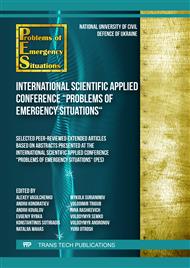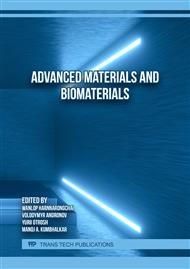[1]
S. Vambol, V. Vambol, O. Kondratenko, Y. Suchikova, O. Hurenko, Assessment of improvement of ecological safety of power plants by arranging the system of pollutant neutralization, Eastern-European Journal of Enterprise Technologies, 3/10-87 (2017) 63–73.
DOI: 10.15587/1729-4061.2017.102314
Google Scholar
[2]
S. Vambol, V. Vambol, Y. Suchikova, N. Deyneko, Analysis of the ways to provide ecological safety for the products of nanotechnologies throughout their life cycle, Eastern-European Journal of Enterprise Technologies, 1/10–85 (2017) 27–36.
DOI: 10.15587/1729-4061.2017.85847
Google Scholar
[3]
W. Zhiming, Q. Yang, Zh. Rong, Manufacture of nuclear fuel elements for commercial PWR in China, 36 (2015).
Google Scholar
[4]
O.V. Yefimov, M. M. Pylypenko, T.V. Potanina, Reaktory i paroheneratory enerhoblokiv AES: skhemy, protsesy, materialy, konstruktsii, modeli, Kharkiv,V spravi, (2017) 420 [in Ukrainian].
Google Scholar
[5]
G.N. Shabanova, A.N. Korohodska, M.V. Kustov, M.Y. Ivashchenko, D.V. Taraduda, Barium-containing cement and concrete for protection against electromagnetic radiation, Functional Materialsthis, 2/28 (2021) 323–326.
Google Scholar
[6]
O. Popov, A. Iatsyshyn, V. Kovach and ets., Analysis of possible causes of NPP emergencies to minimize risk of their occurrence, Nuclear and Radiation Safety, 1/81 (2019) 75–80.
DOI: 10.32918/nrs.2019.1(81).13
Google Scholar
[7]
O. Popov, D. Taraduda, V. Sobyna and ets., Emergencies at Potentially Dangerous Objects Causing Atmosphere Pollution: Peculiarities of Chemically Hazardous Substances Migration, Studies in Systems, Decision and Control, 298 (2020) 151–163.
DOI: 10.1007/978-3-030-48583-2_10
Google Scholar
[8]
S. Ragimov, V. Sobyna, S. Vambol and ets.,Physical modelling of changes in the energy impact on a worker taking into account high-temperature radiation, Journal of Achievements in Materials and Manufacturing Engineering, 1/91 (2018) 27–33.
DOI: 10.5604/01.3001.0012.9654
Google Scholar
[9]
B. Pospelov, R. Meleshchenko, O. Krainiukov and ets., A method for preventing the emergency resulting from fires in the premises through operative control over a gas medium, Eastern-European Journal of Enterprise Technologies, 10–103 (2020) 6–13.
DOI: 10.15587/1729-4061.2020.194009
Google Scholar
[10]
B. Pospelov, V. Andronov, E. Rybka and ets., Mathematical model of determining a risk to the human health along with the detection of hazardous states of urban atmosphere pollution based on measuring the current concentrations of pollutants, Eastern-European Journal of Enterprise, 4/10 (2020) 37–44.
DOI: 10.15587/1729-4061.2020.210059
Google Scholar
[11]
D. Dubinin, V. Avetisyan, K. Ostapov and ets.,Investigation of the effect of carbon monoxide on people in case of fire in a building, Sigurnost 4/62 (2020) 347–-357.
DOI: 10.31306/s.62.4.2
Google Scholar
[12]
O. Popov, A. Iatsyshyn, V. Kovach and ets., Conceptual approaches for development of informational and analytical expert system for assessing the NPP impact on the environment, Nuclear and Radiation Safety, 3/79 (2018) 56–65.
DOI: 10.32918/nrs.2018.3(79).09
Google Scholar
[13]
O. Popov, A. Iatsyshyn, V. Kovach and ets., Physical features of pollutants spread in the air during the emergency at NPPs,Nuclear and Radiation Safety, 4/84 (2019) 11.
DOI: 10.32918/nrs.2019.4(84).11
Google Scholar
[14]
O. Rybalova, S.Artemiev, Development of a procedure for assessing the environmental risk of the surface water status deterioration, Eastern-European Journal of Enterprise Technologies, 5/10–89 (2017) 67–76.
DOI: 10.15587/1729-4061.2017.112211
Google Scholar
[15]
O. Rybalova, S. Artemiev, M. Sarapina and ets., Development of methods for estimating the environmental risk of degradation of the surface water state. Eastern-European Journal of Enterprise Technologies, 2/10–92 (2018) 4–17
DOI: 10.15587/1729-4061.2018.127829
Google Scholar
[16]
B. Pospelov, E. Rybka, V. Togobytska, R. Meleshchenko, Yu. Danchenko,Construction of the method for semi-adaptive threshold scaling transformation when computing recurrent plots, Eastern-European Journal of Enterprise Technologies, 4/10 (100) 22–29.
DOI: 10.15587/1729-4061.2019.176579
Google Scholar
[17]
M. Kustov, E. Slepuzhnikov, V. Lipovoy, I. Khmyrov, Procedure for implementation of the method of artificial deposition of radioactive substances from the atmosphere, Nuclear and Radiation Safety, 3/83 (2019) 13–25.
DOI: 10.32918/nrs.2019.3(83).02
Google Scholar
[18]
H. Fesenko, I. Kliushnikov, V. Kharchenko, S. Rudakov, E. Odarushchenko, Routing an Unmanned Aerial Vehicle during NPP Monitoring in the Presence of an Automatic Battery Replacement Aerial System. Proceedings - 2020 IEEE 11th International Conference on Dependable Systems, Services and Technologies, DESSERT, 9125080 (2020) 34–39.
DOI: 10.1109/dessert50317.2020.9125080
Google Scholar
[19]
B.Pospelov, E. Rybka, R. Meleshchenko, P. Borodych, S.Gornostal, Development of the method for rapid detection of hazardous atmospheric pollution of cities with the help of recurrence measures. Eastern-European Journal of Enterprise Technologies, 1/10–97 (2019) 29–35
DOI: 10.15587/1729-4061.2019.155027
Google Scholar
[20]
V. Sadkovyi, B. Pospelov, V. Andronov, E.Rybka and ets., Construction of a method for detecting arbitrary hazard pollutants in the atmospheric air based on the structural function of the current pollutant concentrations. Eastern-European Journal of Enterprise, 6/10–108 (2020) 14-22.
DOI: 10.15587/1729-4061.2020.218714
Google Scholar
[21]
D. Sokolov, V. Sobyna, S. Vambol, V. Vambol, Substantiation of the choice of the cutter material and method of its hardening, working under the action of friction and cyclic loading, Archives of Materials Science and Engineering, 2/94 (2018) 49–54.
DOI: 10.5604/01.3001.0012.8658
Google Scholar
[22]
D. Dubinin, K. Korytchenko, A. Lisnyak, I. Hrytsyna, V. Trigub, Improving the installation for fire extinguishing with finelydispersed water, Eastern-European Journal of Enterprise Technologies, 2/10–92 (2018) 38–43.
DOI: 10.15587/1729-4061.2018.127865
Google Scholar
[23]
A. Kovalov, Y. Otrosh, S. Vedula, O. Danilin, T. Kovalevska, Parameters of fire-retardant coatings of steel constructions under the influence of climatic factors, Naukovyi Visnyk Natsionalnoho Hirnychoho Universytetu, 3 (2019) 46–53.
DOI: 10.29202/nvngu/2019-3/9
Google Scholar
[24]
R. Kovalenko, A. Kalynovskyi, S. Nazarenko and ets., Development of a method of completing emergency rescue units with emergency vehicles, Eastern-European Journal of Enterprise Technologies, 4/3–100 (2019) 54–62.
DOI: 10.15587/1729-4061.2019.175110
Google Scholar
[25]
K. Korytchenko, O. Sakun, D. Dubinin and ets., Experimental investigation of the fire-extinguishing system with a gas-detonation charge for fluid acceleration, Eastern-European Journal of Enterprise Technologies, 3/ 5–93 (2018) 47–54.
DOI: 10.15587/1729-4061.2018.134193
Google Scholar
[26]
V. Sadkovyi, V. Andronov, O. Semkiv and ets., Fire resistance of reinforced concrete and steel structures, Kharkiv: РС ТЕСHNOLOGY СЕNTЕR, (2021) 180.
DOI: 10.15587/978-617-7319-43-5
Google Scholar
[27]
B. Pospelov, E. Rybka, M. Samoilov and ets., Defining the features of amplitude and phase spectra of dangerous factors of gas medium during the ignition of materials in the premises, Eastern-European Journal of Enterprise Technologies, 2/ 10 – 116 (2022) 57–65.
DOI: 10.15587/1729-4061.2022.254500
Google Scholar
[28]
A.V. Nosovskyi, V.N. Vasylchenko, A.A. Kliuchnykov, B.S. Pryster, Avaryia na Chernobulskoi AES: Oput preodolenyia. Yzvlechennue uroky, K.: Tekhshka, (2006) 264 [in Russian].
Google Scholar
[29]
A.A. Fylchenkov, Avaryia na AES «Fukusyma-1»: vzghliad skvoz pryzmu Chernobulskoi katastrofu, Onkolohiia, 4/17 ( 2015) 268–276 [in Russian].
Google Scholar
[30]
Doklad Heneralnoho dyrektora MAHATE. Avaryia na AES «Fukusyma-daiyty» (2015) 264 [in Russian].
Google Scholar
[31]
M. Kustov, E. Slepuzhnikov, V. Lipovoy and ets., Protsedura realizatsii metodu shtuchnoho osadzhennia radioaktyvnykh rechovyn z atmosfery, Yaderna ta radiatsiina bezpeka, 3/83 (2019) 13-25 [in Ukrainian].
Google Scholar
[32]
S.I. Azarov, V.L. Sydorenko, O.S. Zadunai, Analiz faktoriv tekhnohennoho vplyvu AES na dovkillia, Ekolohichni nauky, 1/1 (2018) 57-65 [in Ukrainian].
Google Scholar
[33]
O. Shugailo, Y. Grebenyuk, O. Zelenyі, Otrymanyi dosvid ta vyvcheni uroky shchodo diialnosti z perekhodu enerhoblokiv AES Ukrainy do dovhostrokovoi ekspluatatsii, Yaderna ta radiatsiina bezpeka, 1/85 (2020) 15-28. [in Ukrainian].
Google Scholar
[34]
Y. Hapon, M. Kustov, V. Kalugin, O.Savchenko, Studying the Effect of Fuel Elements Structural Materials Corrosion on their Operating Life, Materials Science Forum Submitted, 1038 (2021) 108-115.
DOI: 10.4028/www.scientific.net/msf.1038.108
Google Scholar
[35]
V.S. Krasnorutskiy, I.A. Petelguzov, V.M. Gritsina, Issledovaniye vliyaniya VKhR na korrozionnyye protsessy na materialakh aktivnoy zony reaktorov VVER, Voprosy atomnoy nauki i tekhniki, 5 (2010) 58–66 [in Russian].
Google Scholar
[36]
P. Barberis, M. Skocic, D. Kaczorowski, Shadow corrosion: Experiments and modeling, Journal of Nuclear Materials. 523 (2019) 310–319.
DOI: 10.1016/j.jnucmat.2019.06.001
Google Scholar
[37]
A. Pilipenko, H. Pancheva, A. Reznichenko and ets., The study of inhibiting structural material corrosion in water recycling systems by sodium hydroxide, Eastern-European Journal of Enterprise Technologies, 2/1–85 (2017) 21–28.
DOI: 10.15587/1729-4061.2017.95989
Google Scholar
[38]
Yu. Hapon, M. Kustov, M. Chyrkina, O. Romanova, Multistage Corrosion of Fuel Element Materials in Nuclear Reactors.Solid State Phenomena, 334 (2022) 63–69.
DOI: 10.4028/p-0s9zyu
Google Scholar
[39]
G. Lysell, A. Nystrand, M. Ullberg, Shadow Corrosion Mechanism of Zircaloy, Journal of ASTM International, 2 (2005) 1-17.
DOI: 10.1520/jai12374
Google Scholar
[40]
L.M. Soldatkina. Khimichna termodynamika v skhemakh, tablytsiakh, formulakh, rysunkakh, Odeskyi natsionalnyi universytet, (2012) 101 [in Ukrainian]..
Google Scholar
[41]
Y.A. Petelhuzov, A.H. Rodak, E.A. Slabospytskaia, N.Y. Yshchenko. Kynetyka protsessa korrozyy y yzmenenye strukturы kaltsyetermycheskoho tsyrkonyevoho splava Zr1Nb pry nahreve v parakh vodu v oblasty temperatur 660…1200°S, Fizyko-khimichna mekhanika materialiv, 4/89 (2006) 97-103 [in Russian].
Google Scholar



